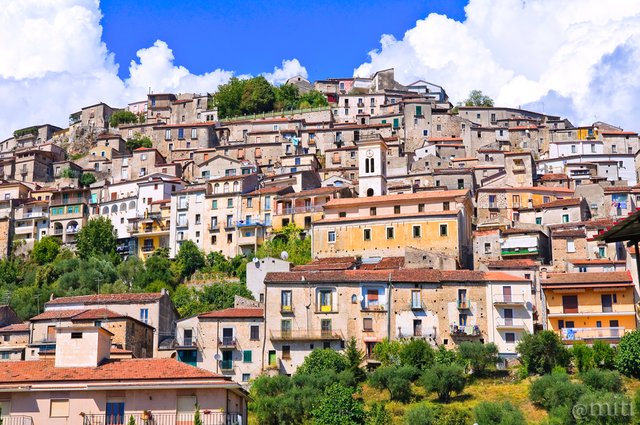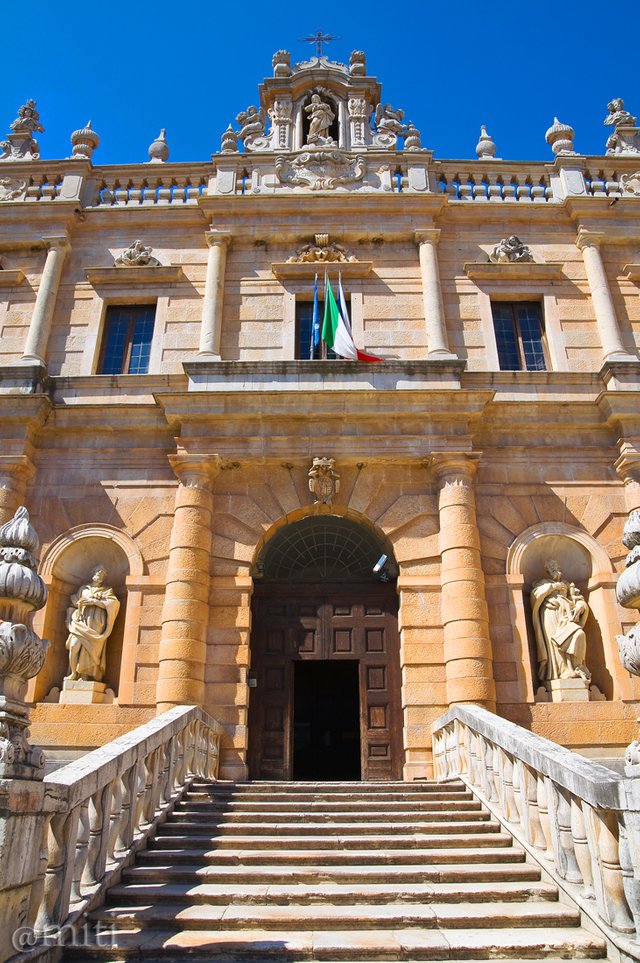A Journey through Italy: one photo every day #99 - PADULA [ENG/ITA]

A panoramic view of Padula (Author's photo - All rights reserved)
Vista panoramica di Padula (Immagine dell'autore - tutti i diritti sono riservati)



Ciao a tutti,
questo è un viaggio attraverso l'Italia. Posterò una foto al giorno con una brevissima descrizione. Spero vi piaccia!

Padula è una città in provincia di Salerno, nella regione meridionale italiana della Campania. Situato in una valle verdeggiante nel cuore del Parco Nazionale del Cilento, Padula si trova tra le montagne e il Mar Mediterraneo.
L'antica città fu inizialmente colonizzata dalla tribù dei Lucani e si trovava in un'area più alta e più meridionale rispetto a quella attuale, chiamata Civita, dove gli scavi hanno provato che questa terra era popolata sin dal XII secolo aC.
I greci si trasferirono qui quando le colonie si stabilirono mentre la Magna Grecia si espandeva e prosperava. Padula era strettamente legata a Paestum e Velia. Fu poi conquistata dai romani che ampliarono le reti e le strade della zona.
I monaci basiliani si trasferirono qui più tardi. Padula fu distrutta dalle incursioni saracene ma ripopolata, divenne un centro di splendore medievale sotto la famiglia Sanseverino, che nel 1296 la ricevette dal Re Carlo II. Questi ultimi dominarono il territorio per secoli, arricchendo Padula con palazzi, piazze, un ospedale, alloggi per operai, chiese ed edifici civili.
Incoraggiarono gli ordini monastici a stabilirsi, cosa che portò Agostiniani e Francescani a stabilirsi qui.
La città di Padula è conosciuta in tutto il mondo per il suo splendido monastero certosino di San Lorenzo, che rende questa città cilentana la principale destinazione per il turismo religioso in provincia di Salerno ed è uno dei monumenti più belli del patrimonio artistico italiano.
Occupa un'area di 51.500 m² e dispone di 3 chiostri, un giardino, un cortile e una chiesa.
La Certosa di Padula fu fondata da Tommaso di San Severino il 27 aprile 1306 sul sito di un precedente monastero. È dedicato a San Lorenzo e la sua struttura architettonica richiama presumibilmente la graticola su cui il santo fu bruciato vivo.
Il monastero ha il chiostro più grande del mondo, che copre 12.000 m² (2.97 acri) e circondato da 84 colonne. Una celebre scala a chiocciola in marmo bianco di forma elicoidale conduce alla grande biblioteca.
Secondo la rigorosa distinzione certosina tra contemplazione e lavoro, ci sono due luoghi distinti per queste pratiche: da un lato i chiostri pacifici, la biblioteca con il suo bel pavimento in ceramica di Vietri, le cappelle decorate con raffinate opere di marmo intarsiato. I frontali dell'altare nella maggior parte delle cappelle sono intarsiati, non in marmo, ma con alcune delle più spettacolari opere in scagliola del 18° secolo secolo mai create.
Il monastero ospita anche il museo archeologico della Lucania occidentale, che conserva una collezione di tutti i reperti rinvenuti negli scavi della necropoli di Sala Consilina e Padula. Questo museo rappresenta un periodo di tempo che va dalla protostoria all'età ellenistica.
Nel 1998 il monastero è stato dichiarato patrimonio dell'umanità dall'UNESCO e nel 2002 il distretto campano lo ha inserito nell'elenco delle principali attrazioni culturali.
Cose da vedere: Il Centro Storico, la Certosa di Padula, la Chiesa di San Michele Arcangelo, la Chiesa della Santissima Annunziata, la Chiesa di San Giovanni Battista, la Chiesa di San Clemente, il Convento di San Francesco di Assisi, Eremo di San Michele a Grottelle.

Hello everyone,
I began a Photo Journey through Italy. I will post one photo every day with a little note of explanation. I hope you like it!

Padula is a town in the province of Salerno, in the southern Italian region of Campania. Set in a verdant valley in the heart of the Cilento National Park, Padula is located between the mountains and the Mediterranean Sea.
The ancient town was first settled by the Lucani tribe and was situated in a higher and more southern area compared to the current one, called Civita, where excavations proved this land has been populated since the 12th century BC.
The Greeks then moved in as the colonies established as Magna Grecia expanded and flourished. Padula was closely tied to Paestum and Velia. It was taken over by the Romans who expanded the area's networks and roads.
The Basilian monks moved in later. Padula was destroyed by Saracen incursions but repopulated. It became a center of medieval splendor under the Sanseverino family, who were given authority over it by King Charles II in 1296. They dominated the territory for centuries, enriching Padula with palaces, piazzas, a hospital, housing for workers, churches and civic buildings.
They encouraged monastic orders to establish themselves, which brought the Augustinians and Franciscans.
The town of Padula is known worldwide for its stunning Carthusian Monastery of Saint Lorenzo, that makes this Cilentan town the main destination for religious tourism in the Province of Salerno and is among one of the most beautiful monuments of Italian artistic heritage.
It occupies an area of 51,500 m² and has 3 cloisters, a garden, a courtyard and a church.
Padula Charterhouse was founded by Tommaso di San Severino on 27 April 1306 on the site of an earlier monastery. It is dedicated to Saint Lawrence, and its architectural structure supposedly recalls the griddle-iron upon which the saint was burnt alive.
The monastery has the biggest cloister in the world, covering 12,000 m² (2.97 acres) and surrounded by 84 columns. A famous spiral staircase of white marble inside an annex leads to the large library.
According to the strict Carthusian distinction between contemplation and work, there are two distinct places for these practices: on the one hand the peaceful cloisters, the library with its fine Vietri ceramic tiled floor, the chapels decorated with fine inlaid marble works. The altar frontals in most of the chapels are inlaid, not with marble, but with some of the most spectacular 18th century scagliola work ever created.
The monastery also houses the archaeological museum of Western Lucania, which preserves a collection of all the finds unearthed in the excavations at the necropolis of Sala Consilina and Padula. This museum represents a period of time ranging from protohistory to the Hellenistic Age.
In 1998 the monastery was declared a UNESCO Heritage of Humanity, and in 2002 the Campania district included it in the list of Major Cultural Attractions.
Thing to see: The Historic Centre, the Padula’s Chartreuse, the Church of San Michele Arcangelo, the Church of Santissima Annunziata, the Church of San Giovanni Battista, the Church of San Clemente, the Convent of St. Francesco of Assisi, Hermitage of St. Michael to Grottelle.

| Tipo di foto / Category | Paesaggio / Landscape view |
| Esposizione / Settings | 1/320 sec, ISO 200, f/10 |
| Camera | Nikon D5000 |
| Lente / Lens | Tamron SP 17-50mm f/2.8 XR Di II LD |
| Filtro / Filter | Polarizzatore Hoya / Hoya Polarizing filter |
| Cavalletto / Tripod | Manfrotto MKC3-P01 |
| Località / Location | Padula (Salerno), Italia |
| Software | Photoshop |


Padula’s Chartreuse (Author's photo - All rights reserved)
La Certosa di Padula (Immagine dell'autore - tutti i diritti sono riservati)
Very beautiful!
Thanks
Love the mountainside neighbourhood aesthetic :)
YES, it's fascinating, really.
Congratulations, Your Post Has Been Added To The Steemit Worldmap!
Author link: http://steemitworldmap.com?author=miti
Post link: http://steemitworldmap.com?post=a-journey-through-italy-one-photo-every-day-99-padula-eng-ita
Want to have your post on the map too?
Come non celebrare i nostri paesi "arrocchettati" sulle montagne, con i loro terrazamenti di casa, una a fianco all'altra, una sopra l'altra, quasi come in un palcoscenico.
Vedendo la prima foto mi viene quasi da pensare che le case siano baciate dal sole.
Io li trovo davvero molto belli da visitare, perchè poi offrono delle panoramiche spettacolari.
@miti church building is very beautifull and the houses on the mountain in the line awesome
Thanks
You got a 31.40% upvote from @ocdb courtesy of @miti!
Congratulations @miti! You have completed the following achievement on Steemit and have been rewarded with new badge(s) :
Click on the badge to view your Board of Honor.
If you no longer want to receive notifications, reply to this comment with the word
STOPTo support your work, I also upvoted your post!
Do not miss the last post from @steemitboard:
SteemitBoard World Cup Contest - The results, the winners and the prizes
woow sir very super
Wow, it was fascinating to follow @miti
The photography is amazingly looking cool
Let me stay put as I wait for the next photos
Thanks for sharing and have a blessed day
Thanks, you too.
#ita
Congratulazioni! Il tuo post è stato votato perchè utilizza il tag #italy e contribuisce alla divulgazione dell'Italia su Steem.
Clicca sulla bandiera per vedere altri post taggati allo stesso modo!
#en
Congratulations! Your post has been upvoted because it uses the tag #italy and contributes to sharing Italy on Steem .
Click on the italian flag to see other posts tagged the same way!